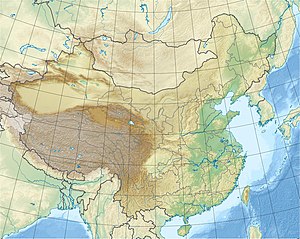Our website is made possible by displaying online advertisements to our visitors.
Please consider supporting us by disabling your ad blocker.
Banpo
半坡 | |
 Reconstructed diorama of a village at Banpo | |
| Location | Shaanxi, China |
|---|---|
| Coordinates | 34°16′23″N 109°03′04″E / 34.273°N 109.051°E |
| History | |
| Founded | 4700 BCE |
| Abandoned | 3600 BCE |
| Periods | Neolithic China |
| Cultures | Yangshao culture |
Banpo is a Neolithic archaeological site located in the Yellow River valley, east of present-day Xi'an, China. Discovered in 1953 by Shi Xingbang,[1] the site represents the first phase of the Yangshao culture (c. 5000 – c. 3000 BCE) and features the remains of several well organized settlements—including Jiangzhai, which has been radiocarbon dated to c. 4700 – c. 3600 BCE).[2][3][4][5] An area of 5 to 6 hectares (12 to 15 acres) was surrounded by a ditch, probably a defensive moat 5 to 6 meters (16 to 20 ft) wide. The houses at Banpo were circular, built of mud and wood on low foundations, with overhanging thatched roofs. There also appear to have been communal burials.[6]
- ^ "Pioneering archaeologist who helped excavate Terracotta Warriors dies at 99". South China Morning Post. 24 October 2022.
- ^ Yang, Xiaoping (2010). "Climate Change and Desertification with Special Reference to the Cases in China". Changing Climates, Earth Systems and Society. pp. 177–187. doi:10.1007/978-9-048-18716-4_8. ISBN 978-9-048-18715-7.
- ^ Crawford, Garry W. (2004). "East Asian plant domestication" (PDF). In Stark, Miriam T. (ed.). Archaeology of Asia. Blackwell. pp. 77–95.
- ^ Fuller, Dorian Q.; Qin, Ling; Harvey, Emma (2008). "A Critical Assessment of Early Agriculture in East Asia, with emphasis on Lower Yangzte Rice Domestication" (PDF). Pragdhara: 17–52.
- ^ Meng, Y; Zhang, H. Q.; Pan, F.; He, Z. D.; Shao, J-.L.; Ding, Y. (2011). "Prevalence of dental caries and tooth wear in a Neolithic population (6700-5600 years BP) from northern China". Archives of Oral Biology. 56 (11): 1424–1435. doi:10.1016/j.archoralbio.2011.04.003. PMID 21592462.
- ^ Jarzombek, Mark M.; Prakash, Vikramaditya (2011). A Global History of Architecture. Wiley. pp. 8–9. ISBN 978-0-470-90245-5.
Previous Page Next Page




